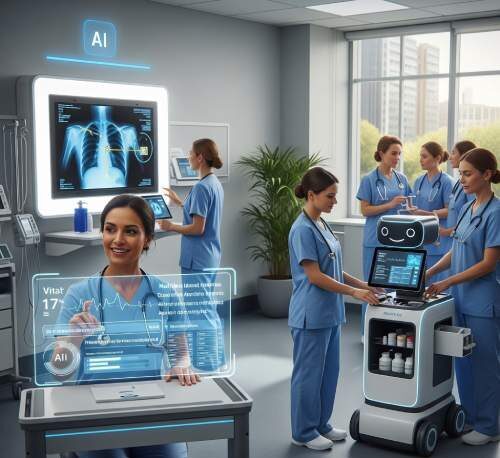Easy Guide: Incorporating Technology and AI in Nursing Teaching 2025

Nursing education is evolving rapidly, and in 2025, one of the most transformative shifts is the integration of Technology and AI in Nursing Teaching. As the healthcare landscape grows more complex and digitally driven, nurse educators can no longer rely solely on traditional teaching approaches.

Instead, the inclusion of advanced tools such as artificial intelligence, simulation software, virtual reality (VR), and digital assessment platforms is becoming essential to prepare students for modern clinical practice. This easy guide explores how educators can effectively incorporate these innovations into teaching, making learning more interactive, efficient, and aligned with today’s healthcare demands.
The use of Technology and AI in Nursing Teaching is not about replacing human educators but about enhancing their capacity to deliver high-quality education. For example, AI-powered platforms can personalize learning by tracking student performance and recommending targeted resources. Simulation labs and virtual patients allow students to practice complex clinical scenarios in a risk-free environment, while digital platforms improve access to resources, collaboration, and feedback. These tools help bridge the gap between classroom learning and real-world application, ensuring nursing students graduate with both competence and confidence.
In this article, we will provide a step-by-step guide on how nurse educators can seamlessly integrate technology and AI into their teaching strategies. From practical classroom applications to overcoming common challenges, this guide will highlight best practices, cost-effective tools, and future trends shaping nursing education. By embracing digital transformation, nurse educators not only enhance student learning but also future-proof the nursing profession for the rapidly advancing world of healthcare.
AI Made Easy: The Ultimate AI Nursing Documentation Guide (2025)
Why Technology and AI Matter in Nursing Education 2025
In 2025, the integration of Technology and AI in Nursing Teaching is no longer optional—it is a necessity. Healthcare systems worldwide are becoming increasingly dependent on digital tools, data-driven decision-making, and advanced patient care technologies. For nursing students to thrive in this environment, their education must mirror the realities of modern practice.
One of the biggest reasons technology matters is preparing students for real-world healthcare systems. Nurses today are expected to use electronic health records (EHRs), telemedicine platforms, and AI-driven monitoring systems as part of their daily work. Introducing these tools in nursing education ensures students graduate ready to adapt.
Artificial Intelligence, in particular, is revolutionizing nursing education. AI-powered platforms can analyze student performance, identify knowledge gaps, and provide personalized learning paths—something traditional teaching methods cannot achieve alone. Virtual simulations and VR-based labs also create safe spaces where students can practice critical skills, from administering medication to responding to emergencies, without putting real patients at risk.
Moreover, technology enhances accessibility and flexibility in nursing education. Online platforms, mobile apps, and AI tutors allow students to learn anytime, anywhere, catering to diverse learning styles and schedules. For educators, digital tools make it easier to track progress, assess competency, and provide immediate feedback.
In essence, integrating technology and AI into nursing education is about more than convenience—it is about future-proofing the nursing workforce, ensuring they are competent, confident, and prepared for the digital age of healthcare.
Key Benefits of Using Technology and AI in Nursing Teaching
Incorporating Technology and AI in Nursing Teaching offers powerful benefits that extend beyond the classroom, shaping both the learning experience and the future of healthcare delivery. 
By adopting these tools in 2025, nurse educators can transform how students learn, practice, and apply nursing knowledge.
1. Personalized Learning Experiences
AI-powered platforms analyze student performance and adapt lessons to individual needs, helping learners strengthen weak areas and progress at their own pace.
2. Enhanced Critical Thinking and Decision-Making
Simulation labs, virtual patients, and scenario-based learning allow students to practice real-life clinical situations, improving confidence and clinical reasoning skills.
3. Improved Student Engagement
Digital tools such as gamified apps, VR simulations, and interactive case studies make learning more engaging and reduce the monotony of traditional lectures.
4. Increased Accessibility and Flexibility
Online platforms and mobile apps allow students to access lectures, practice exams, and clinical resources anytime, anywhere—ideal for diverse learning schedules.
5. Data-Driven Insights for Educators
AI systems track student progress in real time, providing educators with valuable insights to refine teaching strategies and deliver targeted feedback.
6. Safe and Controlled Learning Environment
Virtual simulations and AI-driven labs create safe practice spaces where students can make mistakes, learn, and build confidence without risking patient safety.
By leveraging these benefits, educators not only prepare students for success in exams but also equip them with the digital skills essential for modern healthcare systems.
Challenges of Incorporating Technology and AI in Nursing Teaching
While the integration of Technology and AI in Nursing Teaching has clear benefits, it also comes with challenges that educators must address to ensure effective implementation. Understanding these obstacles is key to developing realistic and sustainable teaching strategies in 2025.
1. High Costs of Implementation
Simulation labs, AI platforms, and VR equipment often require significant investment. Many institutions, particularly in developing regions, may struggle with budget constraints.
2. Limited Digital Literacy Among Educators
Not all nurse educators are fully comfortable with advanced technologies. Without proper training, even the best tools can go underutilized.
3. Technical Issues and Reliability
Dependence on technology means that internet disruptions, software failures, or equipment malfunctions can interfere with learning outcomes.
4. Resistance to Change
Some educators and students may prefer traditional teaching methods and resist adopting new digital tools, making transition slower.
5. Data Privacy and Security Concerns
With AI systems collecting sensitive data on student performance, maintaining confidentiality and complying with privacy regulations is essential.
6. Risk of Over-Reliance on Technology
While AI and simulations are powerful, they cannot fully replace real-life patient interactions. Educators must strike a balance between digital and hands-on clinical teaching.
Despite these challenges, with careful planning, staff training, and institutional support, the use of technology and AI in nursing education can become both sustainable and transformative.
Best Practices for Incorporating Technology and AI in Nursing Teaching 2025
To maximize the benefits of Technology and AI in Nursing Teaching, educators must follow proven strategies that balance innovation with practicality.

The goal is not just to use technology, but to integrate it in ways that enhance learning and prepare future nurses for real-world challenges.
1. Start with Clear Learning Objectives
Before selecting tools, educators should identify what competencies students need to develop. Whether it’s critical thinking, patient communication, or clinical decision-making, technology should directly support those goals.
2. Blend Traditional and Digital Methods
Hybrid teaching approaches—combining lectures, clinical practice, and AI-driven simulations—ensure that students gain both theoretical knowledge and hands-on experience.
3. Provide Faculty Training and Support
Ongoing professional development ensures that nurse educators are comfortable with emerging tools like AI-powered assessments, VR platforms, and learning management systems.
4. Encourage Active Student Participation
Use interactive tools like case-based simulations, AI chatbots for Q&A, and virtual patient encounters to keep students engaged and improve retention.
5. Monitor Student Performance with AI Analytics
Leverage AI systems to track student progress, identify knowledge gaps, and provide tailored feedback for continuous improvement.
6. Ensure Ethical Use of Technology
Educators must teach students not only how to use technology but also how to apply it responsibly—respecting patient privacy, minimizing bias in AI tools, and prioritizing human-centered care.
7. Scale Gradually
Instead of adopting every new technology at once, start small with tools that fit existing curricula and expand as educators and students become more comfortable.
By applying these best practices, nurse educators can transform classrooms and clinical training environments, ensuring that graduates are well-prepared for the tech-driven healthcare systems of 2025 and beyond.
Surprising Telehealth Nursing Training Tips for Success in US 2025
Future of Technology and AI in Nursing Teaching
The future of Technology and AI in Nursing Teaching looks promising, with emerging innovations set to reshape how educators prepare the next generation of nurses. As healthcare becomes more digital, nursing education must evolve to match the pace of change.
1. AI-Powered Personalized Learning
AI will increasingly provide customized learning paths, offering tailored assignments and simulations based on each student’s strengths and weaknesses. This ensures a more efficient and targeted approach to skill development.
2. Virtual Reality (VR) and Augmented Reality (AR) Expansion
By 2025 and beyond, immersive VR and AR environments will allow students to practice complex procedures in risk-free, realistic simulations, bridging the gap between classroom knowledge and clinical practice.
3. Intelligent Assessment Tools
AI-driven systems will make assessments more adaptive, giving immediate feedback and helping educators identify areas that need reinforcement in real-time.
4. Global Collaboration through Digital Platforms
Technology will enable nursing students and educators from different countries to collaborate in real-time, exchanging knowledge and building a stronger global nursing community.
5. Integration of Robotics in Training
Robotics may be introduced to simulate patient scenarios, providing students with a more dynamic and hands-on learning experience.
6. Emphasis on Data and Ethics in Nursing Education
Future curricula will increasingly include data literacy and ethical considerations, ensuring that nurses are equipped to responsibly handle the intersection of patient care and digital technology.
In short, the future is not about replacing nurse educators with machines—it’s about empowering them with smarter tools. Nurse educators who embrace innovation will set their students up for success in an increasingly tech-driven healthcare system.
Conclusion
Incorporating Technology and AI in Nursing Teaching is no longer a futuristic idea—it is a present-day necessity shaping the way nurses learn, practice, and deliver care.

From AI-powered simulations to VR-based clinical training, these tools are transforming classrooms and clinical labs into dynamic, interactive learning environments. While challenges like cost, digital literacy, and ethical concerns remain, the benefits far outweigh the barriers when implemented thoughtfully.
For nurse educators in 2025, success lies in striking a balance—leveraging advanced technologies while preserving the human-centered approach that lies at the heart of nursing. By embracing best practices, fostering continuous learning, and adapting to future innovations, educators can prepare students not only to pass exams but also to excel in the rapidly evolving healthcare landscape.
Ultimately, technology and AI should be seen as powerful allies that enhance, rather than replace, traditional teaching methods. When used strategically, they empower both educators and students to achieve higher levels of competence, confidence, and compassion—qualities that define the nursing profession across the world.
Resources & References
To explore more about Technology and AI in Nursing Teaching, here are some credible resources you can rely on for up-to-date research, guidelines, and best practices:
-
World Health Organization (WHO) – Nursing and Midwifery Education
https://www.who.int/health-topics/nursing -
International Council of Nurses (ICN) – Education and Workforce
https://www.icn.ch/nursing-policy/nursing-education -
National League for Nursing (NLN) – Faculty Development and Teaching Resources
http://www.nln.org -
Journal of Nursing Education and Practice – AI and Simulation in Nursing
https://jnep.sciedupress.com -
NCSBN (National Council of State Boards of Nursing) – Innovations in Nursing Education
https://www.ncsbn.org -
Elsevier – Technology in Nursing Education Research
https://www.elsevier.com
These resources provide in-depth insights into how technology and AI are reshaping nursing education globally.



One Comment